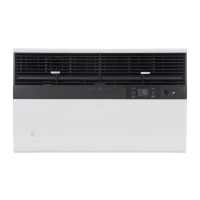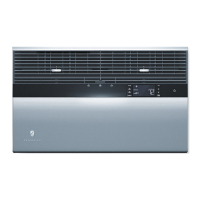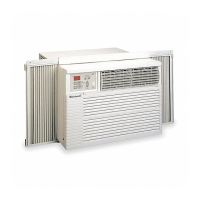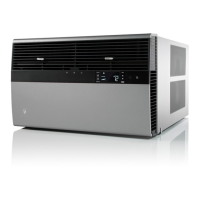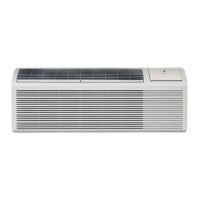Do you have a question about the Friedrich SS14N10A and is the answer not in the manual?
Explains safety alert symbols, warnings, and cautions.
Addresses high-pressure refrigeration systems and general safety first principles.
Guides users through the process of removing the unit from its packaging.
Details requirements for unit wiring, receptacle compatibility, and extension cord prohibition.
Provides instructions for testing the LCDI power cord's functionality before use.
Highlights critical warnings about electrical shock risks and proper grounding.
Instructions for cleaning and installing the standard washable mesh filter.
Steps for installing the optional premium carbon filter for improved air quality.
Describes the main control panel layout, LCD display, and basic functions.
Explains remote control via FriedrichLink and built-in energy management schedules.
Details options for creating custom temperature schedules via USB or wireless adapter.
Explains how to select System modes (Cool, Heat, Fan) and Fan modes (Auto, Continuous).
Describes how to set fan speed manually or use the Auto-adjusting fan speed feature.
Covers adjusting temperature set points and activating Timer or Schedule functions.
Provides steps to set the current time on the air conditioner's control panel.
Explains how to set the current day and switch between Fahrenheit and Celsius.
Details how to adjust the control panel display brightness levels.
Describes the different display brightness levels and filter change alerts.
Explains how to lock and unlock the control panel to prevent accidental changes.
Identifies indicators for remote control and Wi-Fi connectivity status.
Introduces advanced functions like Test Mode and Maintenance Menu, and how to select schedules.
Provides detailed instructions for programming the unit's start and stop times.
Explains the control block behavior and scenarios when the schedule is turned ON.
Details scenarios for Timer ON and when the Schedule function is turned OFF.
Describes various scenarios when the Timer function is turned OFF.
Covers remote control installation, operation range, and basic usage.
Explains the purpose and function of each button on the handheld remote control.
Illustrates the typical operating range and effectiveness of the infrared remote signal.
Instructions on how to adjust the louvers for optimal airflow direction.
Critical safety warnings regarding electrical hazards during the installation process.
Lists the parts provided for installation with straight cooling units.
Lists the tools recommended but not included for installation.
A warning about potential falling objects during installation and risks of injury.
Step-by-step instructions for installing the unit in a standard window opening.
Continues the step-by-step guide for completing window installation.
Emphasizes electrical safety and proper circuit protection requirements for operation.
Details the steps to reroute the power cord from the left to the right side of the unit.
Final steps for routing and securing the power cord to the right side exit.
Warning about potential falling objects during wall installation and associated risks.
Step-by-step instructions for installing the unit through a wall opening.
Continues the step-by-step guide for completing wall installation.
A checklist to ensure all components are installed correctly and ready for operation.
Explains normal operational behaviors like condensation, frosting, and noise levels.
Instructions for cleaning air filters and maintaining indoor/outdoor coils.
Guidance on cleaning the unit's exterior, controls, and maintaining the wall sleeve.
Information on checking troubleshooting tips and contacting customer support for assistance.
Lists optional accessories like carbon filters, installation kits, and decorative front panels.
Addresses issues like the unit not operating, tripping breakers, or LCDI cord issues.
Solutions for insufficient cooling/heating, frequent cycling, and blocked airflow.
Explains why units might run too much or seem less cold, and checks for proper sizing.
Detailed schedule for energy saving during a typical residential work week.
Detailed schedule for energy saving in commercial environments.
Outlines the warranty coverage for parts and labor during the first year.
Covers warranty for the sealed refrigerant system and general limitations.
Explains safety alert symbols, warnings, and cautions.
Addresses high-pressure refrigeration systems and general safety first principles.
Guides users through the process of removing the unit from its packaging.
Details requirements for unit wiring, receptacle compatibility, and extension cord prohibition.
Provides instructions for testing the LCDI power cord's functionality before use.
Highlights critical warnings about electrical shock risks and proper grounding.
Instructions for cleaning and installing the standard washable mesh filter.
Steps for installing the optional premium carbon filter for improved air quality.
Describes the main control panel layout, LCD display, and basic functions.
Explains remote control via FriedrichLink and built-in energy management schedules.
Details options for creating custom temperature schedules via USB or wireless adapter.
Explains how to select System modes (Cool, Heat, Fan) and Fan modes (Auto, Continuous).
Describes how to set fan speed manually or use the Auto-adjusting fan speed feature.
Covers adjusting temperature set points and activating Timer or Schedule functions.
Provides steps to set the current time on the air conditioner's control panel.
Explains how to set the current day and switch between Fahrenheit and Celsius.
Details how to adjust the control panel display brightness levels.
Describes the different display brightness levels and filter change alerts.
Explains how to lock and unlock the control panel to prevent accidental changes.
Identifies indicators for remote control and Wi-Fi connectivity status.
Introduces advanced functions like Test Mode and Maintenance Menu, and how to select schedules.
Provides detailed instructions for programming the unit's start and stop times.
Explains the control block behavior and scenarios when the schedule is turned ON.
Details scenarios for Timer ON and when the Schedule function is turned OFF.
Describes various scenarios when the Timer function is turned OFF.
Covers remote control installation, operation range, and basic usage.
Explains the purpose and function of each button on the handheld remote control.
Illustrates the typical operating range and effectiveness of the infrared remote signal.
Instructions on how to adjust the louvers for optimal airflow direction.
Critical safety warnings regarding electrical hazards during the installation process.
Lists the parts provided for installation with straight cooling units.
Lists the tools recommended but not included for installation.
A warning about potential falling objects during installation and risks of injury.
Step-by-step instructions for installing the unit in a standard window opening.
Continues the step-by-step guide for completing window installation.
Emphasizes electrical safety and proper circuit protection requirements for operation.
Details the steps to reroute the power cord from the left to the right side of the unit.
Final steps for routing and securing the power cord to the right side exit.
Warning about potential falling objects during wall installation and associated risks.
Step-by-step instructions for installing the unit through a wall opening.
Continues the step-by-step guide for completing wall installation.
A checklist to ensure all components are installed correctly and ready for operation.
Explains normal operational behaviors like condensation, frosting, and noise levels.
Instructions for cleaning air filters and maintaining indoor/outdoor coils.
Guidance on cleaning the unit's exterior, controls, and maintaining the wall sleeve.
Information on checking troubleshooting tips and contacting customer support for assistance.
Lists optional accessories like carbon filters, installation kits, and decorative front panels.
Addresses issues like the unit not operating, tripping breakers, or LCDI cord issues.
Solutions for insufficient cooling/heating, frequent cycling, and blocked airflow.
Explains why units might run too much or seem less cold, and checks for proper sizing.
Detailed schedule for energy saving during a typical residential work week.
Detailed schedule for energy saving in commercial environments.
Outlines the warranty coverage for parts and labor during the first year.
Covers warranty for the sealed refrigerant system and general limitations.
| Type | Window Air Conditioner |
|---|---|
| Cooling Capacity | 14000 BTU |
| Refrigerant | R-410A |
| Noise Level | 54 dB |
| Weight | 98 lbs |
| Fan Speeds | 3 |
| Voltage | 115V |
| Plug Type | NEMA 5-15P |
| Power Supply | 115V/60Hz |
| Noise Level (High) | 54 dB |
| Dehumidification | 3.8 pints/hr |


